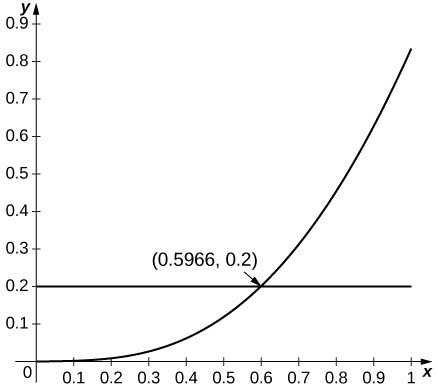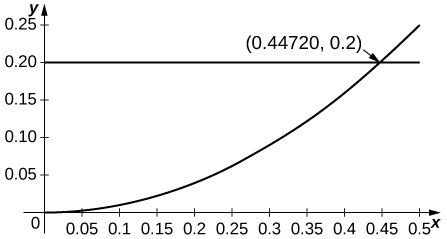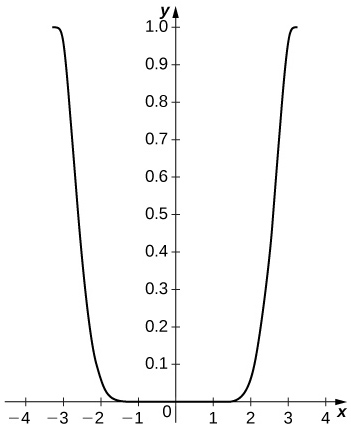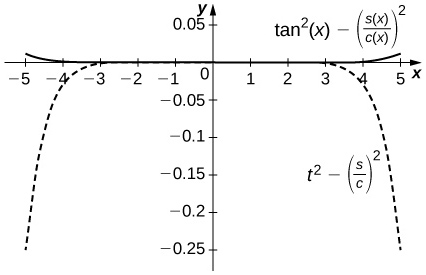1.3E: Exercises
- Page ID
- 17136
This page is a draft and is under active development.
Exercise \(\PageIndex{1}\)
In the following exercises, find the Taylor polynomials of degree two approximating the given function centered at the given point.
1. \(\displaystyle f(x)=1+x+x^2\) at \(\displaystyle a=1\)
2. \(\displaystyle f(x)=1+x+x^2\) at \(\displaystyle a=−1\)
- Answer
-
\(\displaystyle f(−1)=1;f′(−1)=−1;f''(−1)=2;f(x)=1−(x+1)+(x+1)^2\)
3. \(\displaystyle f(x)=cos(2x)\) at \(\displaystyle a=π\)
4. \(\displaystyle f(x)=sin(2x)\) at \(\displaystyle a=\frac{π}{2}\)
- Answer
-
\(\displaystyle f′(x)=2cos(2x);f''(x)=−4sin(2x);p_2(x)=−2(x−\frac{π}{2})\)
5. \(\displaystyle f(x)=\sqrt{x}\) at \(\displaystyle a=4\)
6. \(\displaystyle f(x)=lnx\) at \(\displaystyle a=1\)
- Answer
-
\(\displaystyle f′(x)=\frac{1}{x};f''(x)=−\frac{1}{x^2};p_2(x)=0+(x−1)−\frac{1}{2}(x−1)^2\)
7. \(\displaystyle f(x)=\frac{1}{x}\) at \(\displaystyle a=1\)
8. \(\displaystyle f(x)=e^x\) at \(\displaystyle a=1\)
- Answer
-
\(\displaystyle p_2(x)=e+e(x−1)+\frac{e}{2}(x−1)^2\)
Exercise \(\PageIndex{2}\)
In the following exercises, verify that the given choice of n in the remainder estimate \(\displaystyle |R_n|≤\frac{M}{(n+1)!}(x−a)^{n+1}\), where M is the maximum value of \(\displaystyle ∣f^{(n+1)}(z)∣\) on the interval between a and the indicated point, yields \(\displaystyle |R_n|≤\frac{1}{1000}\). Find the value of the Taylor polynomial \(\displaystyle p_n\) of \(\displaystyle f\) at the indicated point.
1. (\displaystyle \sqrt{10};a=9,n=3\)
2. \(\displaystyle (28)^{1/3};a=27,n=1\)
- Answer
-
\(\displaystyle \frac{d^2}{dx^2}x^{1/3}=−\frac{2}{9x^{5/3}}≥−0.00092…\) when \(\displaystyle x≥28\) so the remainder estimate applies to the linear approximation \(\displaystyle x^{1/3}≈p_1(27)=3+\frac{x−27}{27}\), which gives \(\displaystyle (28)^{1/3}≈3+\frac{1}{27}=3.\bar{037}\), while \(\displaystyle (28)^{1/3}≈3.03658.\)
3. \(\displaystyle sin(6);a=2π,n=5\)
4. \(\displaystyle e^2; a=0,n=9\)
- Answer
-
Using the estimate \(\displaystyle \frac{2^{10}}{10!}<0.000283\) we can use the Taylor expansion of order 9 to estimate \(\displaystyle e^x\) at \(\displaystyle x=2\). as \(\displaystyle e^2≈p_9(2)=1+2+\frac{2^2}{2}+\frac{2^3}{6}+⋯+\frac{2^9}{9!}=7.3887\)… whereas \(\displaystyle e^2≈7.3891.\)
5. \(\displaystyle cos(\frac{π}{5});a=0,n=4\)
6. \(\displaystyle ln(2);a=1,n=1000\)
- Answer
-
Since \(\displaystyle \frac{d^n}{dx^n}(lnx)=(−1)^{n−1}\frac{(n−1)!}{x^n},R_{1000}≈\frac{1}{1001}\). One has \(\displaystyle p_{1000}(1)=\sum_{n=1}^{1000}\frac{(−1)^{n−1}}{n}≈0.6936\) whereas \(\displaystyle ln(2)≈0.6931⋯.\)
Exercise \(\PageIndex{3}\)
1. Integrate the approximation \(\displaystyle sint≈t−\frac{t^3}{6}+\frac{t^5}{120}−\frac{t^7}{5040}\) evaluated at \(\displaystyle π\)t to approximate \(\displaystyle ∫^1_0\frac{sinπt}{πt}dt\).
2. Integrate the approximation \(\displaystyle e^x≈1+x+\frac{x^2}{2}+⋯+\frac{x^6}{720}\) evaluated at \(\displaystyle −x^2\) to approximate \(\displaystyle ∫^1_0e^{−x^2}dx.\)
- Answer
-
\(\displaystyle ∫^1_0(1−x^2+\frac{x^4}{2}−\frac{x^6}{6}+\frac{x^8}{24}−\frac{x^{10}}{120}+\frac{x^{12}}{720})dx =1−\frac{1^3}{3}+\frac{1^5}{10}−\frac{1^7}{42}+\frac{1^9}{9⋅24}−\frac{1^{11}}{120⋅11}+\frac{1^{13}}{720⋅13}≈0.74683\) whereas \(\displaystyle ∫^1_0e^{−x^2}dx≈0.74682.\)
Exercise \(\PageIndex{4}\)
In the following exercises, find the smallest value of n such that the remainder estimate \(\displaystyle |R_n|≤\frac{M}{(n+1)!}(x−a)^{n+1}\), where M is the maximum value of \(\displaystyle ∣f^{(n+1)}(z)∣\) on the interval between a and the indicated point, yields \(\displaystyle |R_n|≤\frac{1}{1000}\) on the indicated interval.
1. \(\displaystyle f(x)=sinx\) on \(\displaystyle [−π,π],a=0\)
2. \(\displaystyle f(x)=cosx\) on \(\displaystyle [−\frac{π}{2},\frac{π}{2}],a=0\)
- Answer
-
Since \(\displaystyle f^{(n+1)}(z)\) is \(\displaystyle sinz\) or \(\displaystyle cosz\), we have \(\displaystyle M=1\). Since \(\displaystyle |x−0|≤\frac{π}{2}\), we seek the smallest n such that \(\displaystyle \frac{π^{n+1}}{2^{n+1}(n+1)!}≤0.001\). The smallest such value is \(\displaystyle n=7\). The remainder estimate is \(\displaystyle R_7≤0.00092.\)
3. \(\displaystyle f(x)=e^{−2x}\) on \(\displaystyle [−1,1],a=0\)
4. \(\displaystyle f(x)=e^{−x}\) on \(\displaystyle [−3,3],a=0\)
- Answer
-
Since \(\displaystyle f^{(n+1)}(z)=±e^{−z}\) one has \(\displaystyle M=e^3\). Since \(\displaystyle |x−0|≤3\), one seeks the smallest n such that \(\displaystyle \frac{3^{n+1}e^3}{(n+1)!}≤0.001\). The smallest such value is \(\displaystyle n=14\). The remainder estimate is \(\displaystyle R_{14}≤0.000220.\)
Exercise \(\PageIndex{5}\)
In the following exercises, the maximum of the right-hand side of the remainder estimate \(\displaystyle |R_1|≤\frac{max|f''(z)|}{2}R^2\) on \(\displaystyle [a−R,a+R]\) occurs at a or \(\displaystyle a±R\). Estimate the maximum value of R such that \(\displaystyle \frac{max|f''(z)|}{2}R^2≤0.1\) on \(\displaystyle [a−R,a+R]\) by plotting this maximum as a function of I.
1. \(\displaystyle e^x\) approximated by \(\displaystyle 1+x,a=0\)
2. \(\displaystyle sinx\) approximated by \(\displaystyle x, a=0\)
- Answer
-
Since \(\displaystyle sinx\) is increasing for small \(\displaystyle x\) and since \(\displaystyle sin''x=−sinx\), the estimate applies whenever \(\displaystyle R^2sin(R)≤0.2\), which applies up to \(\displaystyle R=0.596.\)

3. \(\displaystyle lnx\) approximated by \(\displaystyle x−1,a=1\)
4. \(\displaystyle cosx\) approximated by \(\displaystyle 1,a=0\)
- Answer
-
Since the second derivative of \(\displaystyle cosx\) is \(\displaystyle −cosx\) and since \(\displaystyle cosx\) is decreasing away from \(\displaystyle x=0\), the estimate applies when \(\displaystyle R^2cosR≤0.2\) or \(\displaystyle R≤0.447\).

Exercise \(\PageIndex{6}\)
In the following exercises, find the Taylor series of the given function centered at the indicated point.
1. \(\displaystyle x^4\) at \(\displaystyle a=−1\)
2. \(\displaystyle 1+x+x^2+x^3\) at \(\displaystyle a=−1\)
- Answer
-
\(\displaystyle (x+1)^3−2(x+1)^2+2(x+1)\)
3. \(\displaystyle sinx\) at \(\displaystyle a=π\)
4. \(\displaystyle cosx\) at \(\displaystyle a=2π\)
- Answer
-
Values of derivatives are the same as for \(\displaystyle x=0\) so \(\displaystyle cosx=\sum_{n=0}^∞(−1)^n\frac{(x−2π)^{2n}}{(2n)!}\)
5. \(\displaystyle sinx\) at \(\displaystyle x=\frac{π}{2}\)
6. \(\displaystyle cosx\) at \(\displaystyle x=\frac{π}{2}\)
- Answer
-
\(\displaystyle cos(\frac{π}{2})=0,−sin(\frac{π}{2})=−1\) so \(\displaystyle cosx=\sum_{n=0}^∞(−1)^{n+1}\frac{(x−\frac{π}{2})^{2n+1}}{(2n+1)!}\), which is also \(\displaystyle −cos(x−\frac{π}{2})\).
7. \(\displaystyle e^x\) at \(\displaystyle a=−1\)
8. \(\displaystyle e^x\) at \(\displaystyle a=1\)
- Answer
-
The derivatives are \(\displaystyle f^{(n)}(1)=e\) so \(\displaystyle e^x=e\sum_{n=0}^∞\frac{(x−1)^n}{n!}.\)
9. \(\displaystyle \frac{1}{(x−1)^2}\) at \(\displaystyle a=0\) (Hint: Differentiate \(\displaystyle \frac{1}{1−x}\).)
10. \(\displaystyle \frac{1}{(x−1)^3}\) at \(\displaystyle a=0\)
- Answer
-
\(\displaystyle \frac{1}{(x−1)^3}=−(\frac{1}{2})\frac{d^2}{dx^2}\frac{1}{1−x}=−\sum_{n=0}^∞(\frac{(n+2)(n+1)x^n}{2})\)
11. \(\displaystyle F(x)=∫^x_0cos(\sqrt{t})dt;f(t)=\sum_{n=0}^∞(−1)^n\frac{t^n}{(2n)!}\) at a=0 (Note: \(\displaystyle f\) is the Taylor series of \(\displaystyle cos(\sqrt{t}).)\)
Exercise \(\PageIndex{7}\)
In the following exercises, compute the Taylor series of each function around \(\displaystyle x=1\).
1. \(\displaystyle f(x)=2−x\)
- Answer
-
\(\displaystyle 2−x=1−(x−1)\)
2. \(\displaystyle f(x)=x^3\)
3. \(\displaystyle f(x)=(x−2)^2\)
- Answer
-
\(\displaystyle ((x−1)−1)^2=(x−1)^2−2(x−1)+1\)
4. \(\displaystyle f(x)=lnx\)
5. \(\displaystyle f(x)=\frac{1}{x}\)
- Answer
-
\(\displaystyle \frac{1}{1−(1−x)}=\sum_{n=0}^∞(−1)^n(x−1)^n\)
6. \(\displaystyle f(x)=\frac{1}{2x−x^2}\)
7. \(\displaystyle f(x)=\frac{x}{4x−2x^2−1}\)
- Answer
-
\(\displaystyle x\sum_{n=0}^∞2^n(1−x)^{2n}=\sum_{n=0}^∞2^n(x−1)^{2n+1}+\sum_{n=0}^∞2^n(x−1)^{2n}\)
8. \(\displaystyle f(x)=e^{−x}\)
9. \(\displaystyle f(x)=e^{2x}\)
- Answer
-
\(\displaystyle e^{2x}=e^{2(x−1)+2}=e^2\sum_{n=0}^∞\frac{2^n(x−1)^n}{n!}\)
Exercise \(\PageIndex{8}\)
In the following exercises, identify the value of x such that the given series \(\displaystyle \sum_{n=0}^∞a_n\) is the value of the Maclaurin series of \(\displaystyle f(x)\) at \(\displaystyle x\). Approximate the value of \(\displaystyle f(x)\) using \(\displaystyle S_{10}=\sum_{n=0}^{10}a_n\).
1. \(\displaystyle \sum_{n=0}^∞\frac{1}{n!}\)
2. \(\displaystyle sum_{n=0}^∞\frac{2^n}{n!}\)
- Answer
-
\(\displaystyle x=e^2;S_{10}=\frac{34,913}{4725}≈7.3889947\)
3. \(\displaystyle \sum_{n=0}^∞\frac{(−1)^n(2π)^{2n}}{(2n)!}\)
4. \(\displaystyle \sum_{n=0}^∞\frac{(−1)^n(2π)^{2n+1}}{(2n+1)!}\)
- Answer
-
\(\displaystyle sin(2π)=0;S_{10}=8.27×10^{−5}\)
Exercise \(\PageIndex{9}\)
The following exercises make use of the functions \(\displaystyle S_5(x)=x−\frac{x^3}{6}+\frac{x^5}{120}\) and \(\displaystyle C_4(x)=1−\frac{x^2}{2}+\frac{x^4}{24}\) on \(\displaystyle [−π,π]\).
1. Plot \(\displaystyle sin^2x−(S_5(x))^2\) on \(\displaystyle [−π,π]\). Compare the maximum difference with the square of the Taylor remainder estimate for \(\displaystyle sinx.\)
2. Plot \(\displaystyle cos^2x−(C_4(x))^2\) on \(\displaystyle [−π,π]\). Compare the maximum difference with the square of the Taylor remainder estimate for \(\displaystyle cosx\).
- Answer
-
The difference is small on the interior of the interval but approaches \(\displaystyle 1\) near the endpoints. The remainder estimate is \(\displaystyle |R_4|=\frac{π^5}{120}≈2.552.\)

3. Plot \(\displaystyle |2S_5(x)C_4(x)−sin(2x)|\) on \(\displaystyle [−π,π]\).
4. Compare \(\displaystyle \frac{S_5(x)}{C_4(x)}\) on \(\displaystyle [−1,1]\) to \(\displaystyle tanx\). Compare this with the Taylor remainder estimate for the approximation of \(\displaystyle tanx\) by \(\displaystyle x+\frac{x^3}{3}+\frac{2x^5}{15}\).
- Answer
-
The difference is on the order of \(\displaystyle 10^{−4}\) on \(\displaystyle [−1,1]\) while the Taylor approximation error is around \(\displaystyle 0.1\) near \(\displaystyle ±1\). The top curve is a plot of \(\displaystyle tan^2x−(\frac{S_5(x)}{C_4(x)})^2\) and the lower dashed plot shows \(\displaystyle t^2−(\frac{S_5}{C_4})^2\).

5. Plot \(\displaystyle e^x−e_4(x)\) where \(\displaystyle e_4(x)=1+x+\frac{x^2}{2}+\frac{x^3}{6}+\frac{x^4}{24}\) on \(\displaystyle [0,2]\). Compare the maximum error with the Taylor remainder estimate.
Exercise \(\PageIndex{10}\)
1. (Taylor approximations and root finding.) Recall that Newton’s method \(\displaystyle x_{n+1}=x_n−\frac{f(x_n)}{f'(x_n)}\) approximates solutions of \(\displaystyle f(x)=0\) near the input \(\displaystyle x_0\).
a. If \(\displaystyle f\) and \(\displaystyle g\) are inverse functions, explain why a solution of \(\displaystyle g(x)=a\) is the value \(\displaystyle f(a)\) of \(\displaystyle f\).
b. Let \(\displaystyle p_N(x)\) be the \(\displaystyle Nth\) degree Maclaurin polynomial of \(\displaystyle e^x\). Use Newton’s method to approximate solutions of \(\displaystyle p_N(x)−2=0\) for \(\displaystyle N=4,5,6.\)
c. Explain why the approximate roots of \(\displaystyle p_N(x)−2=0\) are approximate values of \(\displaystyle ln(2).\)
- Answer
-
a. Answers will vary.
b. The following are the \(\displaystyle x_n\) values after \(\displaystyle 10\) iterations of Newton’s method to approximation a root of \(\displaystyle p_N(x)−2=0\): for \(\displaystyle N=4,x=0.6939...;\) for \(\displaystyle N=5,x=0.6932...;\) for \(\displaystyle N=6,x=0.69315...;.\) (Note: \(\displaystyle ln(2)=0.69314...\))
c. Answers will vary.
Exercise \(\PageIndex{11}\)
In the following exercises, use the fact that if \(\displaystyle q(x)=\sum_{n=1}^∞a_n(x−c)^n\) converges in an interval containing \(\displaystyle c\), then \(\displaystyle \lim_{x→c}q(x)=a_0\) to evaluate each limit using Taylor series.
1. \(\displaystyle \lim_{x→0}\frac{cosx−1}{x^2}\)
2. \(\displaystyle \lim_{x→0}\frac{ln(1−x^2)}{x^2}\)
- Answer
-
\(\displaystyle \frac{ln(1−x^2)}{x^2}→−1\)
3. \(\displaystyle \lim_{x→0}\frac{e^{x^2}−x^2−1}{x^4}\)
4. \(\displaystyle \lim_{x→0^+}\frac{cos(\sqrt{x})−1}{2x}\)
- Answer
-
\(\displaystyle \frac{cos(\sqrt{x})−1}{2x}≈\frac{(1−\frac{x}{2}+\frac{x^2}{4!}−⋯)−1}{2x}→−\frac{1}{4}\)


